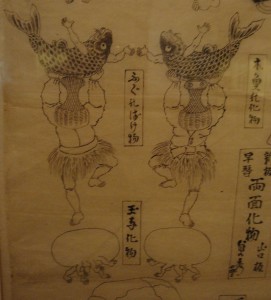The Koh Dynasty (654 – 780AD) in Hokkaido epitomised the extreme separation between the peasants and ruling classes. For a brief period from 776 to 780, a highly ritualised form of sexual etiquette was de rigeur amongst royalty and their coterie.
The form of the koi carp had long been esteemed for beauty and function and archaeological evidence suggests that sexual access to the koi was a privilege limited to the upper classes. However, this scroll from the atelier of master calligrapher Oe (circa 780AD) in Sapporo, gives us a remarkable insight into the level of ritual associated with sexual mores in such rarefied society.
The Koh masters had access to the finest koi carp but the fish tended not to survive the time out of water required for the duration of the ceremonies involved. Instead, the Koh substituted dwarf concubines disguised as fish. This scroll, to be found in the Kyoto Institute of Feudal Studies, displays the section of the ritual in which the ersatz fish are presented to the monarch in preparation for sexual congress.
Under Koh law, deception in misrepresenting the quality and breeding of koi carp was an offence punishable by evisceration. The servants conveying the fish to the proceedings were provided with a ceremonial disguise that would effectively protect them from prosecution. The diminutive imperial prostitutes were completely enclosed by the fish costumes but for their arms and a small but vital opening between the anal fins on the ventral surface.
A section of Koh scripture that was known to all citizens can be translated as:
…and the true emperor shall be made known by the preference of the sacred fish. He who is seized most forcefully by the fish shall be known as the chosen…
Carter and Hiroko, writing in their seminal 1987 study on Koh ritual and custom, postulated that the ‘forceful seizing’ originally pertained to the grip of the cloacal muscles, something unlikely to be accurately perceived by the onlooker. With the increase in importance and complexity of the ceremony associated with sex with the royal fish, it needed to be made clear to very large audiences that the fish was actively choosing the emperor.
At the climax of the ceremony, the fish would flop over to the emperor’s couch, seize him with its arms and demonstrate the potency of the ruler by showing that he was more than able to indulge in energetic sex with the fish. The scroll clearly shows that two fish were provided for the ritual. The costumes were cumbersome, hot and did nothing to facilitate breathing. Often, one of the fish would lose consciousness, in which case it would be replaced by the reserve.
The scroll also hints at the next stage of the ceremony. Following the fish-bearers can be seen comical six-legged pantomime sponges. After the drama of the choosing of the emperor, the mood was lightened by the droll spectacle of the sponges, again small people in restrictive costumes, cleaning the designated ruler after his moist exertions. Demand for confinement-tolerant dwarves was high in the Koh era.

Categories: Uncategorized | No Comments »

